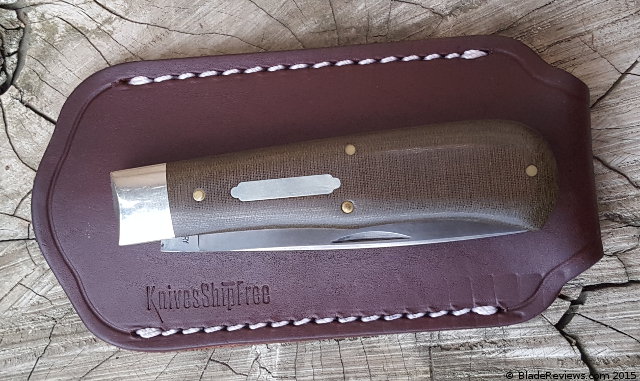Last Update: August 11, 2019
Just a few years ago, it seemed that fans of traditional pocket knives and modern “tactical” folders didn’t intersect. Enthusiasts of modern designs (myself included) were often leery of the carbon steel, clipless carry, and two-handed opening. Before the days of Instagram, the most popular way for people to show off their everyday carry was via forum posts; and while it wasn’t uncommon to see something akin to a Case Peanut pictured alongside a Paramilitary 2, traditional knives were largely relegated to a back-up role. It didn’t help that more than a few of the companies producing traditional knives were bought out and had their labor outsourced to China, which meant that (at the time) quality of materials and manufacture plummeted.
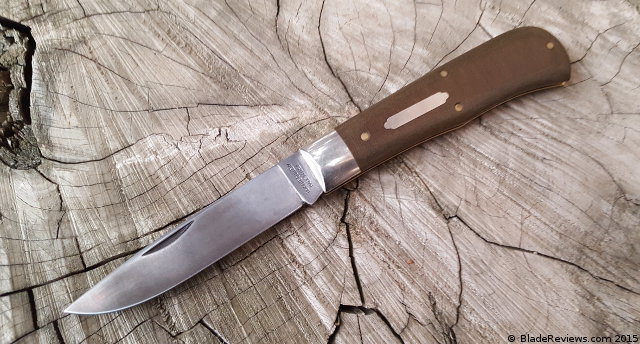
Buy the the GEC Cody Scout at KnivesShipFree
However, over the last few years, companies like Great Eastern Cutlery and Queen have been taking up a larger share of the market for pocket knives. One of the first patterns produced by Great Eastern was the #73, which is based on the two-bladed trapper pattern, one of the classic American traditional knives. I went with a single blade pattern in green micarta. The blade pattern sacrifices some traditional flare in favor of greater utility, while the scales avoid some of the wear problems associated with the natural materials more often used with this type of knife.
General Dimensions and Blade Details
The “Cody Scout” has a single clip point blade, measuring at 3 1/8 inches of 1095 high carbon steel, with a closed length of 3 ¾ inches, an open length of 6 15/16 inches, and weighs in at 2.25 ounces. Oftentimes, clip points come with an exaggerated top swedge, but fortunately Great Eastern chose a sleek, useful blade profile. The already thin stock is taken down to a very fine edge, though yours may need some reprofiling. Evidently Tom Krein is offering regrinds of several GEC knives. Personally, the stock is thin enough that I can’t see the value in having the blade reprofiled, but if anyone can do it right it’s Tom Krein.
Once I had the edge established on mine, it performed with aplomb at slicing tasks, though the 1095 needs regular touch ups. I’ve had better luck with my Sharpmaker than I have with my strop but your mileage may vary. 1095 is frequently seen on traditional folders, and all knives produced by Great Eastern under the Tidioute Cutlery brand make use of it. This steel tends to deform rather than chip out, so those of you who are tired of dealing with S30V’s chipping problems may be intrigued.
As for rust resistance, the steel on my #73 has performed admirably. If needed, I wipe down the blade after use. A dark patina has developed, which helps prevent the iron-like taste high carbon steels can leave during food preparation, and also protects the knife from the more serious red rust. It may sound odd, but I’ve had more problems with rust on 440c and Aus8a blades (both of which are technically stainless). This iteration of the #73 lacks most of the branding typically seen on knives produced by Great Eastern Cutlery. Apart from a tang stamp on each side of the blade, there are no markings, even on the shield inlay.
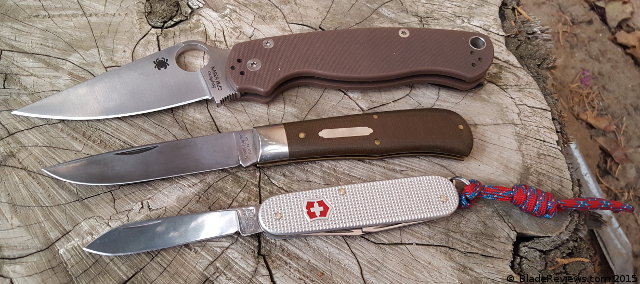
Handle, Ergonomics and Carry
Many traditional knives feature natural materials such as bone, stag, or wood as the covers (for you modern knife guys, scales). These materials are beautiful, warm to the touch, and offer an additional element of refinement over the usual selection of G10 and carbon fiber. However, as natural materials, they are more subject to warping and deformation, which may or may not be a concern to you. I live in what is essentially a desert, complete with triple digits, extreme aridity, and the occasional dust storm (a la The Mummy), and felt more comfortable with micarta. It is a material I never tire of, as it has an organic appearance (similar to bone or wood) but with most of the rigidity and resilience of synthetic materials.
Here, the green linen micarta has been sanded down to a smooth polish. The chamfering on the handles combined with the simple trapper frame makes the knife a pleasure in the hand. I’ve never had hot spots develop in use, and the blade is finished so well that it makes a fantastic worry stone (though I can’t advise that in public). Apart from a hairline gap between the back spring and the brass liner (which is only detectable by holding it up to the light), the quality of manufacturing is immaculate. The #73 is a popular pattern in the GEC line-up, so you will likely be able to select the cover material that suits you best.
I purchased a leather slip case along with the #73. Prior experience with traditionals and large Swiss Army Knives has shown me that clipless knives (barring exceptionally odd dimensions) tend to roll around in the pocket in the course of a day, and quickly become a hassle. The leather pouch is made by KnivesShipFree and distributes the weight of the knife in pocket. While it does add a step to accessing the blade, it makes a knife that I would normally consider unpocketable quite pleasant. Besides, if you are interested in quick access, a traditional is likely not the correct call to begin with. The quality of the slip case is excellent, but one of the nylon stitches (melted together) came loose. Quick application of Fabri-Tac solved the issue, though it’s something to be aware of. I opted for the weatherproof finish for this pouch, but that costs extra.
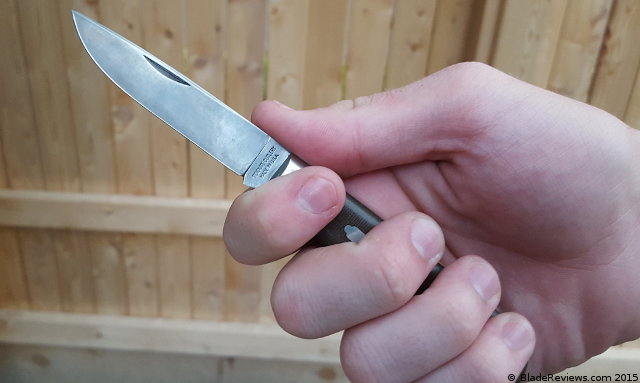
Walk and Talk
The pull on the Cody Scout is smooth, snappy, and very stout. Many reported that the #73 (not the Cody Scout in particular) was a “nail-breaker,” though mine isn’t nearly as tough. It’s worth noting that many of my friends have a hard time opening this knife. If you are acclimated to slip joints, you should be fine, but keep in mind this knife has a reputation for being a bear to open. I prefer to get the pull started with my thumbnail and pinch the blade from that point, as I find the extra purchase helps me open the knife in a more secure fashion. The half-stop doesn’t jerk the blade away from your fingers, which is a concern for some. I prefer slip joints with a strong pull, but that doesn’t mean this knife is safer because of it. As always, use knife sense and exercise caution.
GEC #73 Cody Scout – Final Thoughts
Traditional folders also exist in a space that many knife companies are leaving behind. As framelock flippers have taken over the market, we’ve seen a massive spike of options in the $200 plus range, while the options at less than $100 have stagnated. The average knife from Great Eastern Cutlery will cost you between $70 and $100, which undercuts many of the new offerings from Spyderco, Benchmade, and Zero Tolerance. Although the materials are not bleeding edge, they are from an era when knives were used much more frequently.
One of the reasons folks tossed a small traditional in their pockets on top of the modern knife they were carrying was that traditional knives have a very nonthreatening appearance. Modern folders can attract funny looks in the wrong environment, but traditional folders and multitools don’t seem to suffer from the same problem.
Whether due to clever marketing, an oversaturation of titanium framelock flippers, or a good value proposition, traditional knives are making a comeback. The tight manufacturing tolerances of companies such as Great Eastern and Queen lead me to believe that the resurgence of traditional knives will last.
I’ve been more than satisfied with the #73 in the month or so that I’ve owned it. The 1095 requires regular maintenance, but apart from that, this is close to my ideal everyday carry knife. If you’re the type to fuss over natural materials but want to give traditional knives a try, consider this blade. Personally, the “Cody Scout” seem more timeless than many traditional knives in production, which appear to be thoroughly grounded in the early twentieth century. Even if you’re only looking at traditionals as back-ups to more modern pocketknives, I’d point you to the #73. It possesses enough charm to put all but the most fervent of anti-knife folk at ease, but also wouldn’t be out of place next to a Sebenza.
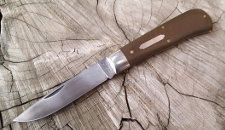
GEC #73 Cody Scout – From $82.53
From: KnivesShipFree
Editor: I recommend purchasing the Cody Scout (and any of its derivatives) at KniveShipFree. Please consider that buying anything through any of the links on this website helps support BladeReviews.com, and keeps the site going. As always, any and all support is greatly appreciated. Thank you very much.
